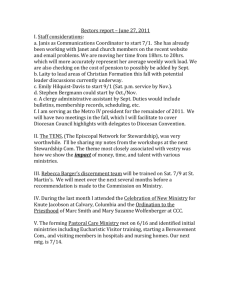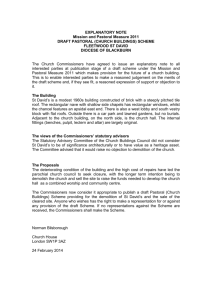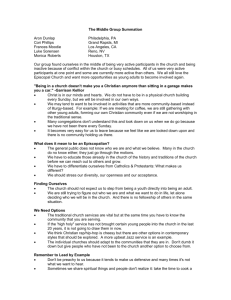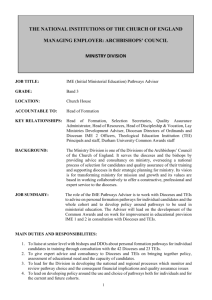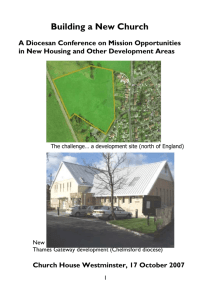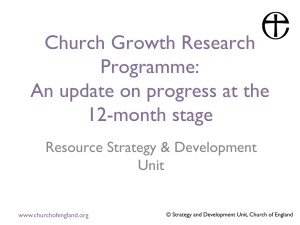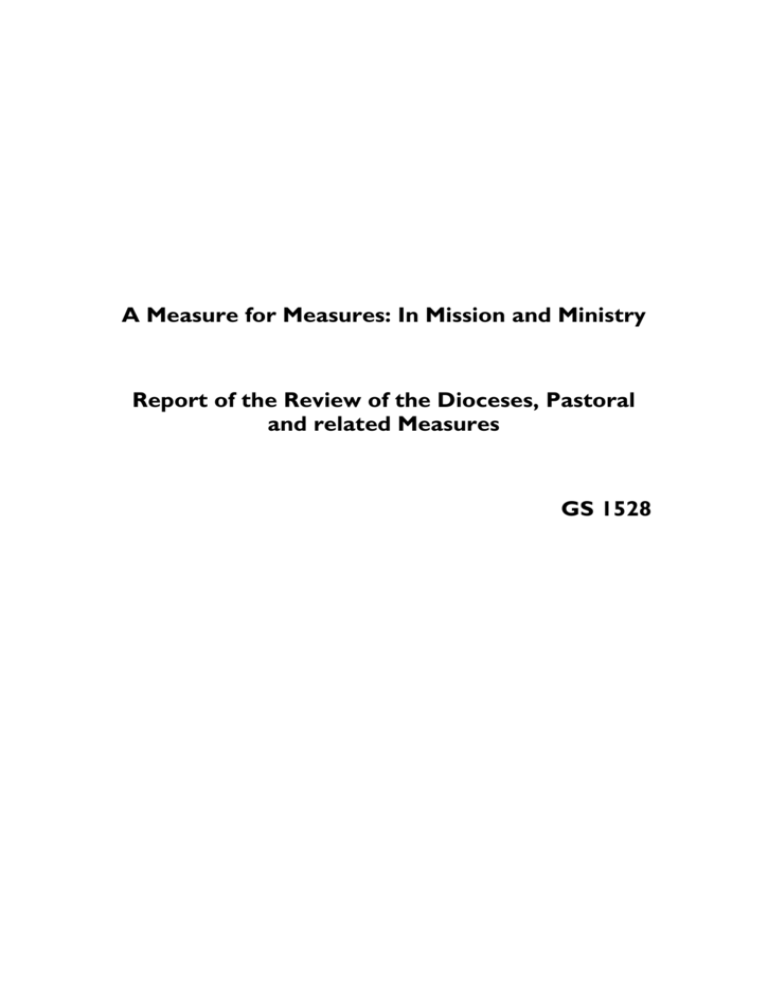
A Measure for Measures: In Mission and Ministry
Report of the Review of the Dioceses, Pastoral
and related Measures
GS 1528
i
Church House Publishing
Church House
Great Smith Street
London SW1P 3NZ
ISBN 0 7151 4029 9
GS 1528
Published 2004 for the Archbishops’ Council by Church House Publishing.
Copyright © The Archbishops’ Council 2004.
All rights reserved. Diocesan offices and national and local heritage bodies have
permission to reproduce this publication in part or in its entirety for local use,
provided the copies include the above copyright notice and no charge is made for
them. Any other reproduction in any form, electronic or mechanical, including
photocopying, recording, or any information storage and retrieval system without
written permission which should be sought from the Copyright Administrator, Church
House Publishing, Church House, Great Smith Street, London SW1P 3NZ (Tel: 020
7898 1594; Fax: 020 7898 1449; Email: copyright@c-of-e.org.uk).
Printed in England by Halstan & Co Ltd, Amersham, Bucks
2
Contents
Terms of Reference
Chairman’s Introduction
Chapter 1: Facilitating the Church’s Mission and Ministry:
Background and Proposals
1.01
1.07
1.09
1.13
Nature of the challenge
Scope of the review
Our approach
Our proposals
- Dioceses
- Neighbourhood and network
- Church buildings
Chapter 2: Dioceses
2.01 Background
2.04 The Dioceses Measure 1978
2.09 Use of the Measure since 1978
2.16 Proposals for the Future
2.20 Duties and Responsibilities of Suffragan Bishops
2.23 A Pro-active Central Body
2.29 Proposals for Amendment of Schemes
2.31 Delay of Nomination to Diocesan Sees
2.32 Shared Administration
2.34 Vacancies in Suffragan Sees
2.38 Sharing of Suffragan and Assistant Bishops
2.40 Names of Sees
2.41 Archdeaconries
Chapter 3: Neighbourhood and Network: Mission, Ministry and
Reorganisation
3.01 The Pastoral Measure 1983
3.05 Purpose and policy context
3.07 Statutory diocesan plans?
3.09 Use of the Measure
3.09 Current provisions
3.10 How they have been used
3.12 Recent trends
3.14 Church and Mission Models
3.17 Potential and limitations of existing provisions
3.21 Case studies of fresh expressions of church
3.22 ‘Mixed economy’ church
3.26 Mission Initiatives
3.28 Definition and scope
3.30 Procedure for creating, renewing or terminating mission initiatives
3.32 Appointments
3
3.33 Governance and representation
3.34 Funds and property
3.35 Integration with existing structures
Ministry arrangements
3.37 Teams and Groups
3.40 Group Ministries
3.41 Team Ministries
3.42 Operation of teams and groups
3.44 Interim provisions for representation of the laity
3.46 Representation of team members on team ministry patronage boards
3.47 Appointment of team vicars
3.48 Team ministries as corporate bodies?
3.49 Ecumenical involvement in teams and groups
3.50 Deployment of Non-Stipendiaries
3.53 Recognising other forms of collaborative ministry
3.54 Suspension of Presentation
3.54 Current Provisions
3.56 Grounds for suspension of presentation
3.59 Appointments of priests-in-charge
3.60 Parsonages
3.60 Freehold of benefice property
3.62 Overlap and conflict between the Pastoral and Parsonages Measures
3.64 Scope for change
3.68 Compensation of clergy
Process
3.72 Initiating Change
3.72 Appointment and role of Diocesan Pastoral Committee
3.74 Archdeaconry or deanery pastoral sub committees?
3.77 Orders and schemes
3.88 Consultation process
3.80 Statutory interested parties
3.81 Consultation stages
3.84 Drafting and publishing schemes and non-shortened procedure orders
3.86 Making schemes
3.87 Effects of our proposals on the consultation process
3.88 Dealing with representations and the appellate function
3.90 Role of the Privy Council
3.92 Section 14 (Shortened Procedure)
3.93 Related Legislation
3.94 New Parishes Measure 1943
3.96 Extra Parochial Ministry Measure 1967
3.97 Priests (Ordination of Women) Measure 1993
3.98 Legislation as to the Faculty Jurisdiction
3.99 Central role
4
Chapter 4: Church Buildings
4.01 Background
4.04
4.06
4.08
4.14
4.16
4.20
4.21
4.24
4.29
4.36
4.37
4.38
4.47
4.49
4.51
4.60
4.63
Churches in Use
The role of church buildings
The provision of church buildings
Facilitating extended use of church buildings
Facilitating strategic reviews of church building needs
Churches no longer required for public worship
Redundancy trends
Terminology and available options
Mothballing
Diocesan bodies and the allocation of functions
4.25 Rationalising the diocesan committee infrastructure
Advisory function
4.30 Current Arrangements
4.32 Single central advisory role?
Church of England (Miscellaneous Provisions) Measure: proposed changes
Identical treatment for unlisted buildings?
Use seeking period
4.38 Length: maximum and minimum
4.42 Use seeking: care and maintenance
4.45 Use seeking: process
Where a use is found
Where a use is not found
Preservation (by the Churches Conservation Trust)
4.53 Constitution and appointment of Trustees
4.54 Powers of the CCT
4.58 Financing the CCT
Demolition
One Stage Procedure
4.64 Section 46 replacement schemes
4.65 Section 47 schemes
Process
4.67 Structure of the Measure
4.68 Declaring a church redundant
4.68 Initiating redundancy
4.71 Churches closed prior to the Pastoral Measure
4.72 Proposals for the future: Pastoral schemes involving redundancy
4.74 Two-stage process
Disposal of churches closed for worship
4.77 Contents
4.77 Contents in the use seeking period
4.78 Disposal of contents
4.83 Dealing with human remains, tombstones, monuments and memorials
4.85 Covenants and residual interest following disposal
4.89 Lease cases
4.90 Central role
5
Chapter 5: Proposed Central functions
- Dioceses
- Neighbourhood and Network
- Church Buildings
5.02 Location of Central Functions
5.08 Human Rights Act considerations
5.16 The central body for Dioceses work
5.21 The central body for Neighbourhood, Network and Church Buildings
Chapter 6: General
6.01 Structure of the Legislation
6.01 General
6.02 Pastoral Measure
6.05 Future amendments
6.06 Education and guidance
6.07 Financial Issues
6.07 Dioceses
6.08 Neighbourhood, network and church buildings
Summary list of recommendations
List of Appendices
Appendix 1: Whose Church? Which Culture?: Discerning the Missionary Structures for
Tomorrow. The Revd Dr Malcolm Brown
Appendix 2: Membership of the Review group
Appendix 3: Bodies and individuals who provided evidence to the Review
Appendix 4: Statistical Overview: 2001
Appendix 5: Pastoral reorganisation – a background note
Appendix 6: Parsonages – a background note
Appendix 7: Redundant churches – a background note
Appendix 8: Abbreviations
List of Tables
Table 1(a): Benefices, parishes, churches and full-time clergy (1969 and 2001)
Table 1(b): Trends in benefices, parishes, churches and full-time clergy (1969-2001)
Table 1(c): Ratio of churches, benefices and parishes to full-time clergy (1969-2001)
Table 2(a) : Example of a deanery based team ministry
Table 2(b): Benefice comprising non-contiguous areas
Table 2(c): Parish of detached parts
Table 3: Consultation response on features of mission initiatives: Q7: ‘Please indicate the
extent to which you regard the following as essential or desirable features.’
Table 4: Number of team ministries created, varied and dissolved (1984 – 2002)
Table 5: Summary of procedure for Pastoral Schemes and Orders
Table 6: Objections by source (1984-2002)
Table 7: Outcomes of pastoral reorganisation objection cases (1984-2002)
Table 8: Number of redundancies since 1969
Table 9: Settling the future of redundant churches (1969-2002)
Table 10: Alternative uses by type (1969-2002)
6
Terms of Reference
The Review of the Dioceses and Pastoral and related Measures Working Group was
appointed by the Archbishops’ Council at the end of 2000 with the following terms of
reference:
“to review in consultation with the dioceses, the Church Commissioners, the
Dioceses Commission and other interested parties the provisions and operation of
the Dioceses Measure 1978, the Pastoral Measure 1983, the Team and Group
Ministries Measure 1995 and related Measures, in order to ensure flexible and costeffective procedures which fully meet changing pastoral and mission needs, and to
report, with recommendations, to the Archbishops’ Council by the summer of
2003”.
7
8
….. for the future take us
Inspired by the line “Past put behind us, for the future take us” in Timothy Dudley-Smith’s
great hymn ‘Lord for the Years’, the temptation in reviewing the Dioceses, Pastoral and
related Measures might so easily have been to set them all aside and start afresh by
considering ‘the future’ alone.
We might even have penned a new following line for the hymn verse: ‘They’re all the past,
so let’s forget them all!’
It was, of course, clear from the outset, as the recently-published Cray Report ‘Mission
Shaped Church’ put it, that “we all live in a fast-changing world. As the Church of England
aims to be a church for everyone in the country…the Church needs to respond to the
changes in our culture”1 and “The sheer variety of fresh expressions of church has been a
welcome sign of continued spiritual creativity in the context of a rapidly changing mission
climate”2. Our primary challenge, therefore, was to determine what legislative framework
might best facilitate the Church’s response for the future; enabling speedy and flexible
responsiveness yet ensuring reasonable good order and accountability.
We consulted widely in order to ascertain the extent to which our ‘past’ Measures
remained ‘fit for purpose’ for the future; unsurprisingly, perhaps, a wide range of opinion
was received - from ‘Leave well alone, the Measures serve us adequately’, through ‘make
significant change, the Measures need serious amendment’, to the ‘past put behind us’ model
‘begin afresh, we need a new, simpler, and far more radically enabling Measure’. There were
also many who professed ignorance about the Measures, but the majority view was
abundantly clear: ‘the baby should not be thrown out with the bathwater’, but significant
change was needed, coupled with far greater ‘lightness of touch’ and flexibility to suit
differing ‘local’ needs and new ways of being Church.
We were determined that our decisions and recommendations should be rooted in an
ecclesiological understanding of the issues involved. We were greatly indebted therefore to
the Reverend Dr Malcolm Brown, our theological consultant, for his constant advice and
encouragement. His observations permeate and punctuate our Report, and his reminder
that “… sometimes, to do familiar things in a changing context is to do something radically
new” became a constant guide in our deliberations. Above all, however, it was his advice
that “It is the theology of oversight – or, episcope –which binds the body together”, that “the
diocese is a very visible expression of Anglican ecclesiology”, and that “the diocese is an
essential tool of mission” that led us to consider the possibility of greater empowerment and
devolved authority for the Dioceses in matters pastoral. We concluded that ‘for the future’,
one size will not fit all, and that although Dioceses are best placed to determine what might
be the ‘best fit’ for their particular mission and ministry needs, a simpler and enabling
national legislative framework is still needed.
1
2
Cray Report (The report of the Breaking New Ground 2 Working Party), Chapter 1
Cray Report, Chapter 2
9
It is, however, ‘the past’ that has produced our present map of Dioceses – a map that selfevidently bears little resemblance to the reality of the present distribution, structure and
mobility of population. Having considered this situation carefully, we concluded that there is
a clear prima facie case for taking a fresh look at the distribution of Dioceses and their
boundaries. To that end, one of our main recommendations is that a new Dioceses
Commission ‘with teeth’ should be given the brief to keep under active review the diocesan
structure of the Church of England, and to make specific proposals for reorganisation to
General Synod. We regard this as an essential concomitant to the greater empowerment we
propose for Dioceses in determining mission and ministry for the people of this nation.
At present, and no doubt for the future, challenging questions also arise about our church
buildings. As our theological consultant reminded us, “church buildings are essentially of the
Interim”; yet many regard them as sacred space and there is wide public interest in what
happens to churches when they are thought to be ‘redundant’. The very word ‘redundant’ is
regarded by many as unhelpful, potentially misleading or unduly negative, and the current
legislation affecting church buildings is perceived by many to be over-prescriptive with its
difficult and excessively time-consuming processes. We have sought, therefore, to simplify
and speed up the processes, facilitate the extended use of church buildings, create greater
flexibility for Dioceses, and provide a single, unified national Church source of information
and advice on church buildings. We have also made specific recommendations to replace the
negative word ‘redundant’ with more appropriate and positive terminology.
Throughout our work we have been wonderfully encouraged and guided by so many people,
but especially by Martin Cavender (who gave us invaluable advice, particularly on mission
initiatives, based on his extensive experience as Director of Springboard) and all those who
took the trouble to respond whether to our questionnaires or to our open invitations to
share their views on the many and complex issues involved. The dedication and skill of the
staff of the Church Commissioners and Church House who so patiently and painstakingly
analysed those responses and finally produced the working drafts of our unanimous report
was, quite simply, magnificent. We are indeed grateful to them all – Martin Elengorn, David
Hebblethwaite, Colin Podmore, Sue Jones, Andrea Mulkeen, Peter Wagon, Jo Winn-Smith
and many others – for their never-tiring support.
In the end, we did not yield to the temptation simply to ‘put past behind us’; rather, we
sought to build on the best of the past Measures, and provide for a new single, coherent
Measure - a significant further ‘step’ - that we believe will facilitate the development of our
‘mission- shaped’ Church, take us with confidence ‘for the future’ and last effectively ‘for the
years’.
Professor Peter Toyne,
Chairman of the Review Group.
10

